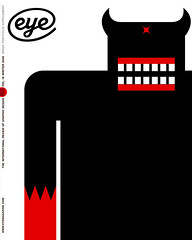Winter 2006
Iran’s tantalising visual revolution
New Visual Culture of Modern Iran by Reza Abedini and Hans Wolbers
Design by Lava<br>BIS Publishers, €39; Mark Batty, Publisher, USD 49.95<br>This survey of new Iranian design work is exciting and frustrating in roughly equal measure. It is exciting because Iranian graphic design is some of the most impressive happening today, and this is the first collection aimed at international readers. In the past few years, Iranian designers have won admiring attention overseas, though to date most of this has come from non-English-speaking countries, particularly France. Iranian designers exhibit regularly in international poster festivals, join international design organisations such as agi and promote their work through groups such as the Iranian Graphic Designers Society and The 5th Color.
Two of the best, Majid Abbasi and Reza Abedini, were included in Area, Phaidon’s compendious global survey of graphic design, published in 2003. Abedini, professor of graphic design at Tehran University and recipient of this year’s prestigious Prince Claus Award, worth a hefty 100,000 euros, is the force behind New Visual Culture of Modern Iran, in collaboration with Dutch designer Hans Wolbers, who describes his own inspiring introduction to the culture, on a recent visit to Iran, in the foreword.
The frustration comes from the fact that, while the images are always fascinating and sometimes stunning, the book tells us little about what we are looking at. A brief, rather general introduction by Abedini sketches in the Persian historical background to contemporary Iranian design, but there are no dates to anchor anything – how many non-Iranians would know when the Qajar and Pahlavi dynasties were? –
or concrete information about who did what, when, or why. The book has a tendency, too, to lump everything together as ‘Iranian visual art’. It may be that the categorical distinctions that still hold sway elsewhere matter less in Iran, but if this is so, and if it is significant for the way that graphic design is perceived and used, then it ought to be spelt out. Abedini’s Dutch publisher should have pressed him for the details that a western readership needs to understand the work’s context and motivations.
The captions are also reticent, providing only the designer’s or artist’s name, a brief description such as ‘poster for painting exhibition’ and the date. A number of ‘experimental’ posters are particularly tantalising. Are these student projects or examples of self-initiated research and development? Luckily, some of the designs contain English text as well as Farsi, enabling inferences to be drawn about pieces that would otherwise remain mysterious. The birth dates provided for many designers, though not all, allow the reader to make a reasonable guess at which of the three generations outlined by Abedini each belongs to – and even this is a help. Broadly, the divisions correspond to careers beginning before, during and after the Iranian revolution in 1979 and the punishing eight-year war with Iraq that followed it. This probably puts Abedini himself (born in 1965) on the cusp of the second and third generation.
The graphic conventions seen in these designs are significantly different from those in recent western work. There is little reliance on straight photography. Fragments of photographs might appear, but these are coloured and ‘posterised’ to absorb them into the image’s overall graphic texture. There is almost no sign here of the exhaustion of graphic language, the desire to somehow ‘dematerialise’ design, found in Europe since the mid-1990s. Direct references to the contemporary reality of technology and consumerism are rare enough to seem almost incongruous – as in a small pair of trainers hanging amid the musical notation in a poster by Farhad Fozouni for a concert by the Tehran Experimental Orchestra, or Amirali Ghasemi’s video art poster constructed around a simplified television remote control to which the artists’ names have been added in the style of information graphics.
As these examples suggest, almost everything in the book has been created for a cultural purpose. Local corporate identities and brands will have to wait for a later volume. Iranian graphic designers are much preoccupied with ways of modernising local calligraphic traditions, and Abedini includes several fluent posters of his own based on energetic contrasts of scale and colour. Letterforms are densely packed into defined areas of the image – it might be a head or a section of the body – and English words flow easily among the Farsi phrases, often in a style that recalls early 1990s experimental typography. This fluid interpretation of western typography works well.
There is no obvious rationale, though, for one of the book’s more whimsical inclusions, a couple of spreads and some loose photos from an anonymous, undated, spiral-bound, hairdresser’s portfolio. The images reveal that an earlier generation of Iranian men possessed a taste for precisely cut and extravagant quiffs.
Rick Poynor, writer, Eye founder, London
First published in Eye no. 62 vol. 16 2006
Eye is the world’s most beautiful and collectable graphic design journal, published quarterly for professional designers, students and anyone interested in critical, informed writing about graphic design and visual culture. It is available from all good design bookshops and online at the Eye shop, where you can buy subscriptions and single issues.

